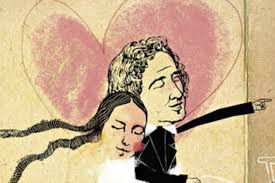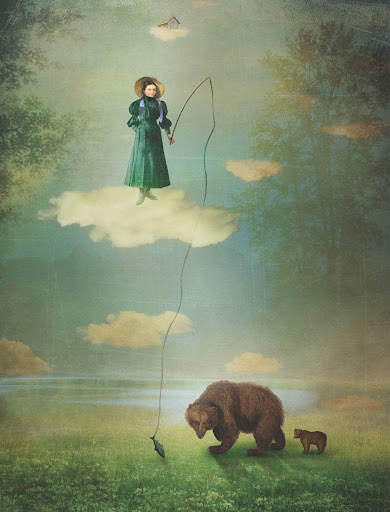I have always loved fairy tales. Given a copy of Grimm's Fairy Tales as a little girl, I was enchanted by its stories: the girl with impossibly long hair locked away in a tower, the princes turned into swans, the sleeping castle hidden behind thorns.
Growing up, I thought that the Grimm brothers were elderly men dressed in knickerbockers, who had travelled about Germany collecting tales from old women knitting by the fire in their rocking-chairs, before publishing their collection to universal acclaim. I could not have been more wrong.
Illustration by Petros Bouloubasis/The Illustration Room.
The true story of how the Grimms Märchen came to be published is as brimful of romance and danger and beauty as any fairy tale. It is the story of how a young man called Wilhelm Grimm met a girl with a silver tongue, a girl who knew so many tales she could keep telling them for hours, a girl who was his one true love. Her name was Dortchen Wild and she grew up living next door to him.
The Wilds and the Grimms lived in the small, mediaeval quarter of Kassel, a town famous for its forests, castles and gardens. Wilhelm was the second eldest in a family of five boys and one girl. Dortchen was the second youngest of one boy and six girls. They met when Dortchen was 12, after the Grimms moved to Hesse-Kassel.
Germany did not yet exist, then, for this was the early 1800s - Hesse-Kassel was one of a patchwork of small kingdoms. Napoléon Bonaparte, who had conquered Egypt and Italy, had turned his avaricious gaze upon the Holy Roman Empire in central Europe, and on his way, his Grand Army marched through Hesse-Kassel. The Prince-Elector fled and Hesse-Kassel became part of the Kingdom of Westphalia.
Life was hard for the Hessians under French occupation. Any attempts at resistance were brutally put down, and the streets were filled with spies. The Grimms were so poor they could only afford a single meal a day.
Angry, hungry, and aggravated by French rule, Wilhelm and his elder brother, Jakob, decided to fill their days by saving the old tales they remembered from their childhood. They began by copying out fables from their library, then they asked their friends and neighbours to contribute.
Dortchen was only 19, but she had a vast storehouse of stories to draw upon - Hansel and Gretel, Rumpelstiltskin, The Frog-King, The Six Swans, The Elves and the Shoemaker and All-Kinds-of-Fur. Her father disapproved of the impoverished young scholar, so Dortchen told Wilhelm her stories in secret, in the garden and in her sister's summerhouse.
I like to think this is when they fell in love. I can see them clearly, Wilhelm dressed in his shabby black coat, Dortchen wearing a soft white dress, her hair pinned in plaits. She speaks eagerly, with expressive hands, adopting different voices for the different characters. His quill scratches quickly over the paper, scattering drops of ink in his haste. As she speaks the words of the heroine in her story, "I have followed you for seven years. I have been to the sun and the moon and the four winds to ask for you ..." I can imagining his eyes intent on hers, the heat rising in her cheeks.
But they could not marry. Dortchen's father was strict and puritanical, and he expected her to stay and care for him and his wife. Even when both her parents had died, Wilhelm was far too poor to support a wife. He and his brothers had to burn their furniture to keep from freezing, and cut up their sister's dresses to make cravats.
The Grimm brothers' Children's and Household Tales was published in 1812, the year of Napoleon's march on Moscow. It was a failure. Only 900 copies sold in the next three years. Worse, they were critically lambasted. One reviewer said the stories were "the most pathetic and tasteless material imaginable". They were criticised for including a story about an unwed teenage mum (Rapunzel), and a girl who takes a frog into her bed (The Frog King).
A second volume of tales, published in 1814, sold only 137 copies in the first year. Napoleon, meanwhile, escaped from his exile on Elba, and raised an army that was finally defeated at the terrible battle of Waterloo. Famine bit its fangs into Europe in 1816, known as "the year without a summer".
Jakob got a job for the newly restored Prince-Elector, trying to retrieve the art stolen by the Bonapartes, and so ceased to help in the project. Wilhelm, however, worked on. With Dortchen's help, he rewrote the fairy tales to make them more suitable for children and commissioned his youngest brother, Ludwig, to illustrate a children's edition, which was published in early 1825 and, finally, began to sell well.
At last, Wilhelm and Dortchen were able to marry. She was 32 years old, Wilhelm seven years older. "I have the premonition that I am going to be happy for the rest of my life," Wilhelm wrote to a friend a few days later. "She is soulful, natural, understanding, and bright. She takes joy in the world and is nonetheless prepared in every moment to give herself over to something higher and better."
And Wilhelm and Dortchen lived happily ever after.







